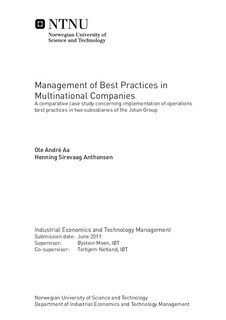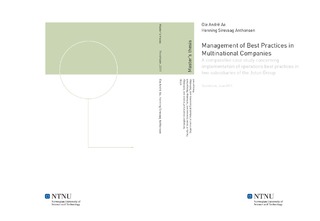| dc.description.abstract | As the modern business world has entered a state of what has been called a hurricane of globalization , the incentives for manufacturing companies to enhance their competitiveness are higher than ever. Many multinational manufacturing companies now choose to implement operations best practices like Lean Manufacturing in their multi-plant manufacturing networks in order to accomplish this. The Jotun Group is a multinational manufacturer of paint which has established Jotun Operations Academy a training program for employees in order to transfer best practices to the company s subsidiaries. However, headquarters has experienced that the effect of the improvement initiative has varied between the company s subsidiaries, and wants to learn why this is the case. Literature within the area has recognized several barriers which may occur when introducing new best practices to an organizational unit. The aim of this study is to increase the understanding of the conditions that influence implementation of operations best practices in the subsidiaries of a multinational company. In order to accomplish this, a comparative case study of two manufacturing units in the Jotun Group is conducted, investigating one plant in Flixborough (England) and one plant in Jakarta (Indonesia). Through the comparative case study, the study will i) investigate the degree of best practice implementation in the two subsidiaries, ii) identify factors which have influenced the implementation and iii) provide an explanation for the different outcomes of the two cases. The choice of using a case design builds on voices in the literature which argue that implementation of a best practice depends on multiple contextual conditions. Drawing on the strengths of such a research design, the study employs multiple sources of evidence, such as: semi-structured and un-structured interviews, direct observation, documentation and a survey. Further, in order to guide the collection of empirical data, the study uses theory from seven streams of literature: Absorptive Capacity Theory, Contingency Theory, Change Management, Agency Theory, Corporate Socialization, Resource Dependency Theory, and the cultural dimensions of GLOBE. The background for the comparative study was a perception that the Flixborough-plant had achieved major improvements through employment of the new practices, while not much had happened in Jakarta. The investigations create a more nuanced impression of the current situation; the managers in Jakarta have indeed made some attempts to use the new practices, and the practices are to some degree implemented in the organization. Still, local managers are finding it difficult to achieve results from the new practices, and both managers and other employees are losing focus on the practice implementation. In comparison, the best practices are much more widespread in the Flixborough organization. Employees are found to value the practices to a greater extent than in Jakarta, suggesting that one has achieved a higher level of internalization. This appears to have had a positive effect on the ability to create lasting changes in the organization.The study identifies 23 factors which have contributed to the different states of implementation in Flixborough and Jakarta. These are appearing on three levels of analysis: subsidiary level, company level and national level. The identified factors are used to construct and propose a multidisciplinary model for factors influencing best practice implementation in a multinational context, presented on page 80. Although the findings suggest a complex interaction between multiple factors on different levels, the discussion identifies some particular conditions as major determinants for the different outcomes in the two cases. First, in line with Absorptive Capacity Theory, the discussion shows how the plant in Flixborough clearly had a major advantage over the one in Jakarta due to higher levels of prior relevant knowledge and practical experience. Second, the discussion reveals several differences in the way the local change processes were managed, the most essential factor appearing to be local top managements efforts as a driving force in Flixborough. Third, a discussion drawing on Agency Theory goes a long way to explain the different behaviours of the managers at the two plants, as the discussion reveals misaligned incentives between headquarters and local managers in Jakarta. Fourth, a strictly limited degree of monitoring from headquarters appears to have made room for the misdirected efforts from the Indonesian managers. Some cultural factors are found to function as potential restraints for the implementation, but not as determinants of the final outcome.For managers of multinational parent companies, the findings imply that providing theoretical knowledge about best practices to local managers is not enough in itself. In order to achieve higher levels of implementation, local managers must both possess a practical understanding of how to translate practices into results, and have incentives to perform considerable efforts on behalf of the implementation initiative. As a contribution to theory, the explanatory power of each of the employed theoretical perspectives is discussed. Further, the study clearly indicates the value of distinguishing between different levels of implementation, and to recognize that a units ability to make use of operations best practices is a major issue during best practice transfer. A main limitation of the study is the restricted number of cases, and future researchers are encouraged to test the proposed model on a higher number of manufacturing plants preferably also across several parent companies. | nb_NO |

